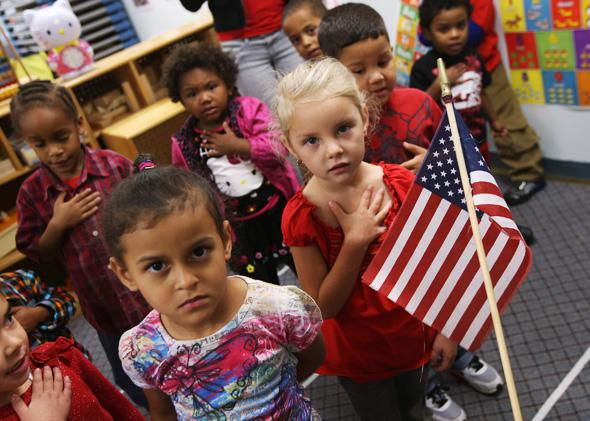How does the government shutdown affect higher ed? The general consensus is that immediate disruptions will be minimal for most universities: Certain campus-based financial aid programs may be affected, as this Inside Higher Ed piece points out, and of course, federal money for scientific research is bottlenecked for the moment. Though the consequences become more serious the longer the shutdown goes on, for now, most universities are putting on a concerned but stoic face.
But how are actual college students affected by the shutdown? Most accounts talk about students as different from workers and parents. Yet story after story about the consequences of the shutdown on Head Start, WIC, and housing subsidies feature recipients who are parenting and working while also going to college. Many rely on programs hardest hit by the shutdown. Fifty-two percent of college students who live on their own are living below the poverty line. For the neediest college students, the government shutdown can force hard choices with higher-ed consequences. For example, Victoria Thomas, an undergraduate at Florida A&M University and a mom, told the Tallahassee Democrat that she’d have to take out more student loans to pay for child care in the wake of the shutdown, which has forced the closing of nine Head Start programs in the Tallahassee area.
I wanted to look up the exact percentage of single parents currently enrolled in higher education, but the federally funded database of that information has been shut down. Fortunately, Sara Goldrick-Rab of the University of Wisconsin–Madison has a good bead on trends among nontraditional students and access to higher education. According to Goldrick-Rab’s stats, the proportion of unmarried parents in college has nearly doubled over the past 20 years, from 7 percent of the total undergraduate population to about 13 percent, and 36 percent of African-American female undergraduates are single mothers. The economic reality for all single parents struggling to get through college is tough: low wages, economic precarity, and a greater risk of dropping out. The No. 1 concern for these parents is child care. When only half of all colleges provide any kind of child care services, student-parents are vulnerable to disruptions to programs like Head Start. New York’s PIX11 reported on Katimi Bouare, a mother of four who juggles housecleaning jobs and college courses to improve her job prospects—a schedule that becomes impossible for Bouare if Head Start closes. With one of the weakest family-policy safety nets of any industrialized nation, low-income single parents in the U.S. rely greatly on programs like Head Start, not only to augment a child’s development but to expand work and college options by freeing up a single parent’s scarcest resource: time.
Should a student-parent find the time, there’s still the issue of money. Child care is not cheap. According to a study by Child Care Aware of America, in 2011 the average annual cost of full-time day care for an infant in a center ranged from about $4,600 in Mississippi to nearly $15,000 in Massachusetts. Putting those statistics in the context of tuition shows what kinds of choices single parents in college must make. Child Care Aware also found that in most states, those same annual day care costs were higher than a year’s in-state tuition and fees at a four-year public college. For these college students, the effects of the college shutdown can force a decision between dropping out or, like Thomas, accruing more student loan debt to protect the educational investment they’ve already made.
But even those college students who find a way to meet their child care needs during the shutdown may face an even bigger concern: going hungry. As of Tuesday, the government had stopped funding the Special Supplemental Program for Women, Infants, and Children; J’Kai Jackson told NBC News that without support from WIC, she would “have to drop out of school to find work to provide food for my child.” Jackson is far from alone. Almost 30 percent of college students have household incomes that qualify them for some kind of social welfare program. College attendance is a centerpiece of the neoliberal take on welfare as contingent on work. With lifetime caps on how long you can be on welfare, the goal is to move from welfare to work quickly, and at any short-term cost. But finding work isn’t easy. Not only does a college education prepare students for better and more secure work, but studying for a degree can also help students meet their welfare eligibility requirements. When the shutdown brings social welfare programs like WIC to a halt, low-income students stand a bigger risk of dropping out.
Serving students dealing with fears about food, shelter, and child care is already difficult for institutions struggling with state budget cuts. The federal shutdown doesn’t help. We speak most often of how declining subsidies affect community colleges, and for good reason. But historically black colleges and universities have long recognized serving low-income students as a cornerstone of their institutional mission. At the majority of HBCUs, two-thirds of students qualify for need-based federal Pell Grants, a common measure for high financial need. Both community colleges and HBCUs fill the gap with support from programs like the Federal Supplemental Educational Opportunity Grant, which is designed to “give priority to students with the highest need”—the kind who might also need day care and food and housing subsidies. New applications for the grant can’t be processed at the moment, with 90 percent of the Department of Education’s staff on furlough.
The effects of the federal shutdown on women and the working poor have compounded consequences for students who are both. What’s lost in our coverage is the context of the daily choices college students face, and how they are different for different kinds of students. Institutions of higher education may have contingency plans to buffer the effects of the government shutdown, but many of our neediest students do not.
